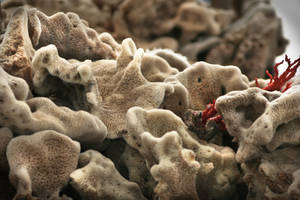Microbes living on sea sponges produce a host of potent drugs,  scientists have discovered.
scientists have discovered.
Sponges are regarded as a rich source of potential new drugs, ranging from antibiotics to anti-cancer therapies.
But the concentrations of these agents are tiny, meaning that preclusively large numbers of sponges would need to be harvested to yield useful drug quantities, and exactly why and how these marine animals should make such a broad repertoire of chemicals wasn't understood.
Also hard to explain was the observation that sponges living in different environments produced very different profiles of chemicals.
Now, a research team at Bonn University have solved the puzzle with the discovery of a bacterium called Entotheonella palauensis, which lives on and in the sponge and appears to be the source of the observed chemical wizardry.
Writing in Nature, Michael Wilson and his colleagues collected and broke up sponges to produce a "sponge soup", which was added in small amounts to individual culture dishes.
Growing within some of the cultures, the team found long filament-like chains of bacterial cells, joined end to end and resembling strings of bricks.
DNA extracted from the micro-organisms showed that they were endowed with genes capable of producing a broad repertoire of biological molecules, including some of the therapeutic chemicals previously isolated from sponges.
Tests on the microbes confirmed that they were indeed producing these substances.
Finding these bugs in one species of sponge doesn't prove the rule though, so the researchers also analysed a further 37 sponge species from a range of geographies, of which the bacteria from 28 of them were up to 99.9% genetically matched with the Entotheonella palauensis bugs the team had been working on.
Outstanding questions now are whether other marine organisms also harbour these bugs, who are the relatives of these talented microbes and what other chemistries might they be capable of...
- Previous Predicting risky choices
- Next Hacking into the Beijing cough










Comments
Add a comment